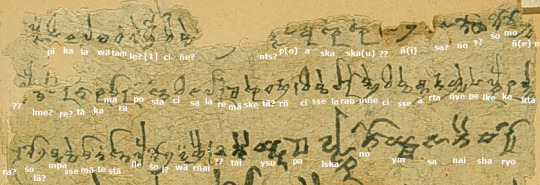Text

Above is my attempt at transcribing the first three lines of TH 496, that haunting fragment of Kuchean poetry. AIUI, in Tocharian B, the transcription convention uses ä for /ɨ/, ṣ for /ʃ/, ś for /ɕ/, c for /tɕ/, and ñ for /ɲ/. The ṃ is just a variant for /n/. So I think these lines would be pronounced something like:
jaltse pikala watɨn le -ɲo tɕi ɲe -- -- -- -- -- -nts po askaskau ma ɲi sa noʃ ɕomo ɲem wnolme la:re ta:ka ma: ra postan cisa la:re mɨsketɨrɲ ciʃʃe laraumɲe ciʃʃe a:rtaɲje pelke kaltta- rrɨ ɕolɨmpa ʃʃe ma: te sta:lle ɕol wɨrɲai taijsu pɨlskanojm sanai ʃarjo
Some fun cognates: śomo is cognate to Latin homo, OE guma (modern "groom," with an intrusive r due to the compound "bridegroom"); ñem is cognate to English "name;" and wnolme is cognate to Latin animus.
At least some of the consonant clusters in Tocharian B were eventually simplified in pronunciation--apparently later in the same manuscript someone has written lykautkañ for klyautkañ, "make, turn into;" the initial cluster was probably pronounced /l/, which makes this an error roughly on par with writing "nkow" instead of "know," because you know there's a k in there somewhere but it's not pronounced.
The Tocharian script is essentially a local form of the Brahmic script, and operates on the same principle: in theory, it is an abugida where each sign is a consonant with an inherent /a/ or /ə/ vowel, and diacritics mark the other vowels (as well as standalone vowels), while a virama marks final consonants with no vowel. In practice, Brahmic scripts (especially older ones) seem to be a a lot more complicated, because consonant sequences are represented by stacking signs on top of one another, and this can produce a dizzying array of fearsome ligatures. The annoying thing about Tocharian is that I actually can't find any good resources online about the writing system as it's actually used--mostly a list of the basic signs (which, as you might expect, are not in fact the majority of signs used in a text like this!), without any indication of what common variants or simplifications look like.
It helps, of course, that cheat sheets exist for this sort of thing, so you can check your work as you go. But I would definitely classify this text--or at least the hand responsible for the first two and a half lines--as "not especially clear examples of the script." I think it would also be kind of annoying to learn in that the division into signs doesn't really match up with natural syllabification at all--there's this kind of fucked up maximal onset principle thing going on where instead of writing <war nai> or <kalt tar rä> you have to write <wa rnai> and <ka ltta rra>, which seems like it would have been very annoying. Seems like it would be very easy to transition an abugida into an alphabet, too--you already have standalone signs for all the vowels!
But there's no denying that like a lot of scripts in the family, it looks great. Just A+ aesthetic, up there with Syriac and katakana.
#apparently the tocharian languages straight up just merged all three PIE stop series#which seems like it would cause enormous problems#also the relationship between the languages is... weird#tocharian a seems to have been kind of a liturgical language?#but it's not ancestral to tocharian b#like it's clearly a sister language#i need to buy that book on tocharian
18 notes
·
View notes